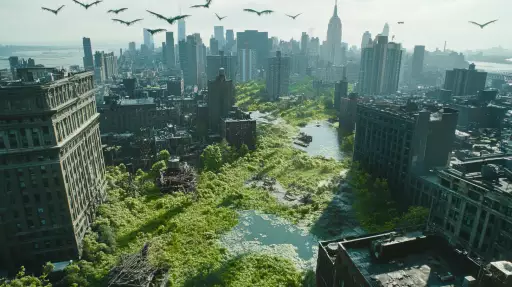Explore the Best AI Image Gallery

Pixelated Portraits: How AI-Generated Visual Content is Transforming Creativity
The creative landscape is undergoing a seismic shift, powered by the rise of artificial intelligence (AI). No longer confined to the realm of science fiction, AI-generated visual content is rapidly becoming a tangible force, blurring the lines between human and machine creativity. This blog post explores this fascinating phenomenon, delving into its impact on the creative industry, potential applications, ethical considerations, and future trends.
A New Palette for Creativity
AI-powered tools can now generate stunning visuals, from realistic photographs and paintings to abstract art and imaginative designs. These algorithms learn from vast datasets of existing images, identifying patterns and styles to create entirely new pieces. This opens up a world of possibilities for artists, designers, and content creators:
- Streamlined Design Process: AI can assist in generating multiple design concepts rapidly, saving time and resources for creatives.
- Personalized Content: Imagine AI tools tailoring visuals to individual preferences, creating unique artwork or marketing materials.
- Breaking Creative Barriers: Individuals with limited artistic skills can leverage AI to bring their visions to life, democratizing the creative process.
Beyond Aesthetics: Applications Across Industries
The impact of AI-generated visual content extends far beyond the realm of art. Its applications are rapidly proliferating across diverse industries:
- Advertising and Marketing: Dynamically generated visuals for targeted campaigns, personalized product visualizations.
- Gaming and Entertainment: Creating realistic game environments, generating procedural content like textures and characters.
- Education and Training: Simulating scenarios, visualizing complex data, creating interactive learning experiences.
- Healthcare: Generating patient-specific medical images for diagnosis and treatment planning.
Navigating the Ethical Terrain
As with any powerful technology, AI-generated visual content raises important ethical considerations:
- Copyright and Ownership: Who owns the rights to AI-generated artwork? Is it the creator of the algorithm, the user who provides input, or the AI itself?
- Bias and Representation: AI algorithms can inherit biases from the data they are trained on, potentially leading to unfair or inaccurate representations.
- Job Displacement: The automation potential of AI raises concerns about the impact on creative jobs and industries.
The Future Canvas: Trends and Predictions
The field of AI-generated visual content is rapidly evolving. Here are some key trends to watch:
- Increased Realism and Personalization:** AI will continue to generate increasingly realistic and personalized visuals, tailored to individual preferences and contexts.
- Democratization of Creativity: User-friendly AI tools will empower more people to create visual content, regardless of their technical expertise.
- Ethical Frameworks and Regulation:** The development of ethical guidelines and regulations will be crucial to ensure responsible use of AI in creative applications.
AI-generated visual content is not a replacement for human creativity but rather a powerful tool that can augment and enhance it. By embracing its potential while addressing the ethical challenges, we can unlock new frontiers of artistic expression and innovation.




![**Representation: A dog acting as a private tutor to a child. The dog holds a ruler in its paw and stands at the blackboard to explain a dog diagram to the child. Graphic style: Line drawing, cartoon style, influenced by Franco-Belgian comics, thick black lines, simplified design, vector, black and white only, in the style of Keith Haring or the French comic strip "Alinéa". [IMPORTANT]: A single continuous line extending from one side of the image to the other, minimalist, strong outlines, line drawing, without lifting the hand, ultra-simplified, no shading, entirely white image, drawing created in the center of a sheet of paper. --ar 16:5** - Variations (Strong) by <@627984126871470085> (fast)](https://images.ai-img.art/thumbnails/150/f4e034998ccd869d8a061fd12017514fcd92210eb33d4222dc9b54716223f4dd.webp)




](https://images.ai-img.art/thumbnails/150/157712d76865d557120f9baf988de3d0525225295a2789c89bf2c4a5a96a03d1.webp)







](https://images.ai-img.art/thumbnails/150/9d51c5e673b4f2068b7b01abc35425a06f173b76303adf9ad29ca14302c25b18.webp)














](https://images.ai-img.art/thumbnails/150/51c93500396faff4e7fa8b42bc68033067b16b2230e3496e95c482a581ff0fe9.webp)






![**Representation: A teenager smiling while thinking about a friendly dog, a comic-style thought bubble with a friendly dog inside. Graphic style: Line drawing, cartoon style, influenced by Franco-Belgian comics, thick black lines, simplified design, vector, black and white only, in the style of Keith Haring or the French comic strip "Alinéa". [IMPORTANT]: A single continuous line extending from one side of the image to the other, minimalist, strong outlines, line drawing, without lifting the hand, ultra-simplified, no shading, entirely white image, drawing created in the center of a sheet of paper. --ar 16:5** - <@627984126871470085> (fast)](https://images.ai-img.art/thumbnails/150/6fc850f638e3dee0c4b121acecad2c8419e02bdeac7f871d625f1003c1c3abe1.webp)
![**Representation: A dog acting as a private tutor to a child. The dog holds a ruler in its paw and stands at the blackboard to explain a dog diagram to the child. Graphic style: Line drawing, cartoon style, influenced by Franco-Belgian comics, thick black lines, simplified design, vector, black and white only, in the style of Keith Haring or the French comic strip "Alinéa". [IMPORTANT]: A single continuous line extending from one side of the image to the other, minimalist, strong outlines, line drawing, without lifting the hand, ultra-simplified, no shading, entirely white image, drawing created in the center of a sheet of paper. --ar 16:5** - <@627984126871470085> (fast)](https://images.ai-img.art/thumbnails/150/7a854648a81e51241dcca8d24dd6e3bfcf07ad1df51baf401c9b729f4cf411fa.webp)



